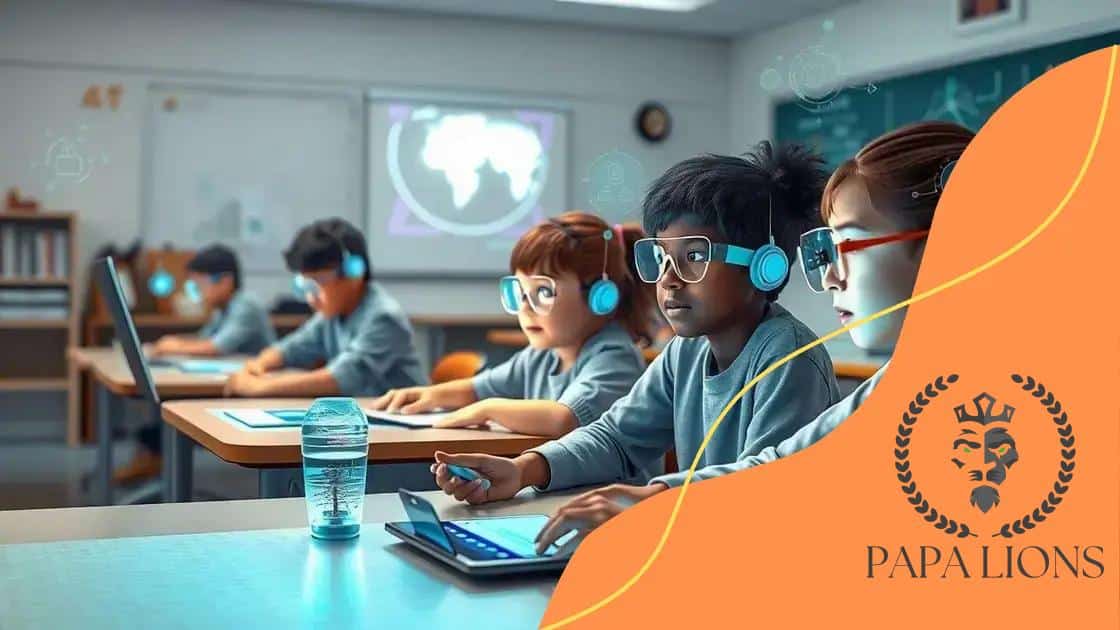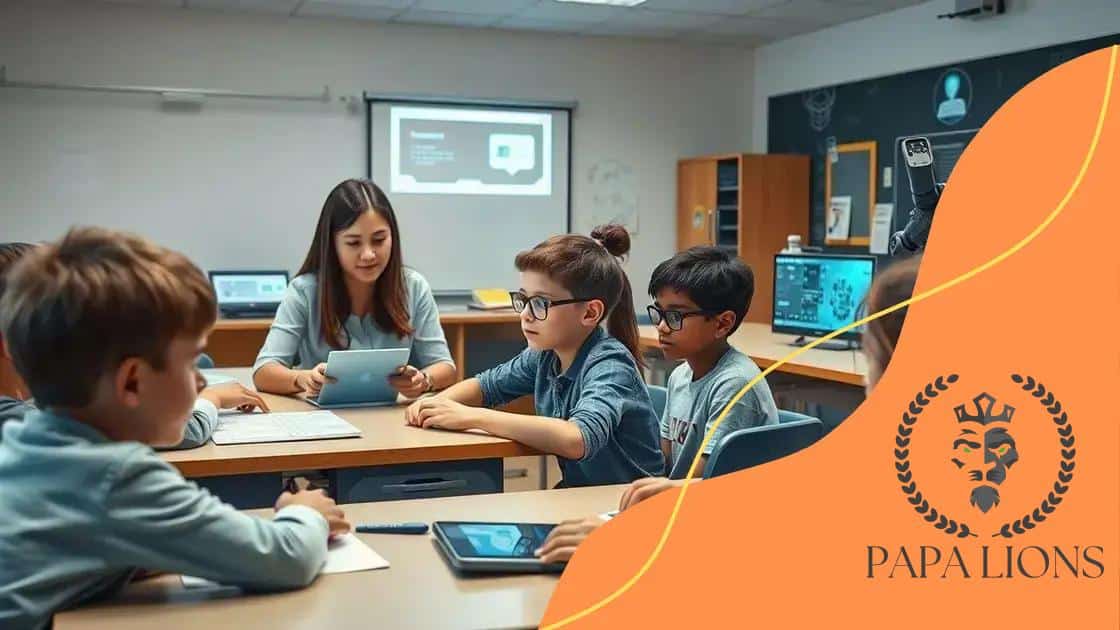AI support for special education: enhancing learning experiences

AI support for special education enhances personalized learning by providing tailored resources, adaptive learning tools, and data-driven insights, ensuring that diverse learners receive the best educational experiences.
AI support for special education is changing the landscape of learning for students with unique needs. Have you ever wondered how technology can create an inclusive environment? In this article, we’ll delve into the impact of AI on educational experiences.
Understanding AI in special education
Understanding how AI can enhance special education is critical for educators and parents alike. With the rise of technology, it’s essential to explore how AI solutions can support diverse learning needs.
What is AI?
Artificial Intelligence refers to the simulation of human intelligence in machines that are programmed to think and learn. In education, this technology can adapt to different learning styles.
Key Benefits of AI in Special Education
- Personalized Learning: AI can tailor lessons to meet individual needs.
- Real-Time Feedback: Students receive instant evaluations, helping them understand their progress.
- Enhanced Engagement: Interactive tools keep students motivated and focused.
- Data-Driven Insights: Teachers gain valuable information about student performance.
By integrating AI into the classroom, teachers can better identify the strengths and weaknesses of each student. This enables customized lesson plans that cater specifically to those needs.
Furthermore, AI tools can help track student progress over time. For example, applications designed for students with learning disabilities provide features that assist with reading comprehension or math skills.
Communicating with parents is also easier as AI systems can generate reports detailing their child’s learning habits. This transparency helps parents engage more effectively in their child’s education. Overall, understanding AI in special education opens up new pathways for support and success.
Benefits of AI support for diverse learners
The benefits of AI support for diverse learners are immense. By leveraging technology, educators can create inclusive environments that cater to each student’s unique needs. With tailored resources, teachers can enhance the learning experience for everyone.
Enhanced Accessibility
AI tools can adapt content to different learning styles and abilities. For example, speech-to-text applications allow students with writing difficulties to express their thoughts effortlessly.
Individualized Learning Plans
- Personalized curriculum: AI can design lesson plans to fit individual learning paths.
- Adaptive assessments: Tests can adjust in real-time, matching the student’s level of understanding.
- Goal tracking: AI can help monitor progress, making it easier to set and achieve learning objectives.
This level of customization can significantly improve a student’s confidence. With tools to guide their learning, students can explore subjects at their own pace.
Incorporating AI into the classroom ensures that every learner has access to resources that match their needs. As a result, students who might struggle in a traditional setting often thrive when provided with the right technological support.
Additionally, teachers benefit from AI support. They gain insights through data analytics, allowing them to adjust their teaching strategies and better engage their students. By automating administrative tasks, teachers also have more time to focus on direct instruction.
Practical applications of AI tools in the classroom

Practical applications of AI tools in the classroom enhance learning experiences and make teaching more effective. Teachers are using this technology to engage students in new and exciting ways.
Interactive Learning Experiences
AI can create interactive lessons where students actively participate. For instance, using chatbots allows students to ask questions and get immediate answers, making the learning process more engaging.
Adaptive Learning Software
- Personalized lessons: Software can adjust the difficulty based on the learner’s progress, ensuring they remain challenged without becoming frustrated.
- Instant feedback: Students receive feedback on their work in real-time, helping them improve quickly.
- Multimedia resources: AI can suggest relevant videos, articles, and other materials that cater to students’ interests.
This adaptability helps meet the diverse needs of all learners in the classroom. Additionally, AI tools can assist teachers in identifying areas where students struggle.
For example, assessment tools powered by AI can analyze student performance data. Teachers can use this information to adjust their instruction and provide targeted support to those who need it most.
Moreover, classroom management software streamlined by AI helps educators organize tasks and enhance communication with parents, ensuring everyone stays informed about student progress.
Challenges in implementing AI solutions
Implementing AI solutions in education comes with various challenges. While the potential benefits are significant, educators must navigate several obstacles to make the most of this technology.
High Costs of Implementation
One major challenge is the cost associated with integrating AI tools. Schools may struggle to find funding for new technologies, including software and hardware.
Training and Support
- Teacher training: Educators need proper training to effectively use AI systems. Without training, they may feel overwhelmed.
- Technical support: Schools require ongoing support to troubleshoot issues that arise with AI software.
- Change in methodology: Adapting to new teaching methods can be challenging for seasoned teachers.
Overcoming these hurdles is vital for a successful transition to modern educational practices. Additionally, not all students may adapt to AI technologies at the same pace.
Some students could face difficulties when adjusting to new systems, leading to potential disengagement from learning. Teachers need to be prepared to offer additional support to these learners.
Moreover, data privacy and ethical concerns arise when using AI in education. Protecting student information is crucial as schools adopt more digital solutions. Understanding how to maintain security and compliance is a responsibility that schools must take seriously.
Future trends in AI and special education
The future trends in AI and special education show great promise. As technology continues to evolve, we can expect innovative solutions that will further enhance learning for students with diverse needs.
Increased Personalization
One major trend is the move toward even more personalized learning experiences. AI tools will analyze individual student data to create customized lesson plans that adapt in real-time. This means that each student can learn at their own pace and in their own way.
Integration of Virtual Reality (VR)
- Immersive learning: Virtual reality can create immersive environments for students to experience lessons firsthand.
- Simulation of real-world scenarios: VR tools can help students practice social skills or navigate different situations safely.
- Increased engagement: Interactive experiences capture students’ attention, making learning more enjoyable.
As AI technology continues to advance, we may see an increase in the use of VR in classrooms. These immersive experiences make lessons more engaging and can cater to various learning styles.
Another trend is the expansion of collaboration between educators and technology developers. As schools advocate for tools that meet their students’ needs, developers are more likely to create tailored solutions that address those needs effectively.
Additionally, we can expect improvements in accessibility tools. Innovative apps and software will continue to emerge, providing support for students with disabilities. These tools will make learning resources easier to navigate.
The future of AI in special education highlights the importance of fostering inclusivity and accessibility. By harnessing the power of technology, educators can better support students and create environments where all learners can thrive.
In conclusion, the integration of AI in special education offers exciting possibilities. As we navigate these changes, it is essential to prioritize personalized learning, accessibility, and continuous support for both educators and students. By embracing AI tools, we can create enriching environments where every learner can thrive and achieve their potential. The journey ahead will undoubtedly be transformative, laying the foundation for a more inclusive and effective educational system.
FAQ – Frequently Asked Questions about AI in Special Education
How does AI improve personalized learning for students?
AI analyzes individual student data to create tailored lessons, allowing each learner to progress at their own pace.
What are some practical AI tools used in the classroom?
Common AI tools include adaptive learning software, chatbots for real-time feedback, and virtual reality applications for immersive learning.
What challenges do schools face when implementing AI solutions?
Schools often encounter high costs, the need for teacher training, and data privacy concerns when adopting AI technologies.
How can AI support teachers in special education?
AI can provide valuable insights from data analysis, helping teachers adjust their methods and focus on students who need extra support.





